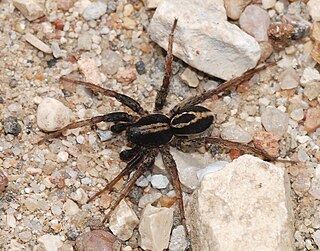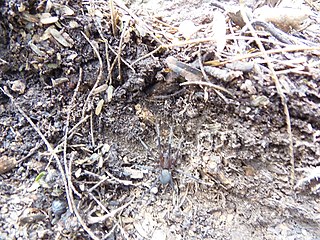
The sac spiders of the family Clubionidae have a very confusing taxonomic history. Once, this family was a large catch-all taxon for a disparate collection of spiders, similar only in that they had eight eyes arranged in two rows and conical anterior spinnerets that touched, and were wandering predators that built silken retreats, or sacs, usually on plant terminals, between leaves, under bark, or under rocks. These are now recognized to include several families, some of which are more closely related to the three-clawed spiders, like lynx and wolf spiders, than to Clubionidae and related families.
Zorocratidae is a formerly accepted family of spiders. Most of the genera formerly placed in this family have been transferred to the family Udubidae. The type genus, Zorocrates, is now placed in the Zoropsidae.

Zoropsidae, also known as false wolf spiders for their physical similarity to wolf spiders, is a family of cribellate araneomorph spiders first described by Philipp Bertkau in 1882. They can be distinguished from wolf spiders by their two rows of eyes that are more equal in size than those of Lycosidae.

Cribellum literally means "little sieve", and in biology the term generally applies to anatomical structures in the form of tiny perforated plates.

Lycosoidea is a clade or superfamily of araneomorph spiders. The traditional circumscription was based on a feature of the eyes. The tapetum is a reflective layer at the back of the eye, thought to increase sensitivity in low light levels. Lycosoids were then defined by having a "grate-shaped" tapetum. Research from the late 1990s onwards suggests that this feature has evolved more than once, possibly as many as five times, so that the original Lycosoidea is paraphyletic. Studies published in 2014 and 2015 suggest that a smaller group of families does form a clade.

Zoropsis is a spider genus in the family Zoropsidae. The genus was described in 1878 by Eugène Simon.

The RTA clade is a clade of araneomorph spiders, united by the possession of a retrolateral tibial apophysis – a backward-facing projection on the tibia of the male pedipalp. The clade contains over 21,000 species, almost half the current total of about 46,000 known species of spider. Most of the members of the clade are wanderers and do not build webs. Despite making up approximately half of all modern spider diversity, there are no unambiguous records of the group from the Mesozoic and molecular clock evidence suggests that the group began to diversify during the Late Cretaceous.
Zorodictyna is a genus of spiders in the family Udubidae native to Madagascar. It has been described as an intermediate genus between Zoropsidae and Dictynidae, though it is now placed in Udubidae. This genus was originally placed in the family Zoropsidae, but it has been reassigned several times since. In 1967, Lehtinen moved it to Miturgidae. In 1999, it was moved back to Zoropsidae, and in 2015, it was moved to Udubidae.
Devendra pardalis is a species of spider of the family Zoropsidae. It is endemic to Sri Lanka.
Devendra pumilus, is a species of spider of the family Zoropsidae. It is endemic to Sri Lanka.
Devendra seriatus is a species of spider of the family Zoropsidae. It is endemic to Sri Lanka.
Lauricius is a genus of North American false wolf spiders that was first described by Eugène Louis Simon in 1888. As of September 2019 it contains two species, found in the United States and Mexico: L. hemicloeinus and L. hooki. Originally placed with the sac spiders, it was transferred to the Zoropsidae in 1967.
Liocranoides is a genus of American false wolf spiders that was first described by Eugen von Keyserling in 1881. They live in habitats with cold surfaces, such as caves. It was transferred from the sac spiders to the Tengellidae in 1967, which was later merged with Zoropsidae.

Socalchemmis is a genus of North American false wolf spiders that was first described by Norman I. Platnick & D. Ubick in 2001. The genus name comes from a shortening of the phrase "Southern Californian Chemmis", as the genus was discovered in California.
Hoedillus is a genus of spiders in the family Zoropsidae. It was first described in 1898 by Simon. As of 2017, it contains only one species, Hoedillus sexpunctatus, found in Guatemala and Nicaragua.

Zorocrates is a genus of spiders in the family Zoropsidae. It was first described in 1888 by Simon. As of 2017, it contains 31 species.
Griswoldia is a genus of southern African false wolf spiders. It was first described by A. S. Dippenaar-Schoeman and Rudy Jocqué in 1997, and it has only been found in South Africa.
Krukt is a genus of spiders in the family Zoropsidae. It was first described in 2005 by Raven & Stumkat. As of 2017, it contains 5 species, all found in Queensland.
Phanotea is a genus of spiders in the family Zoropsidae. It was first described in 1896 by Simon. As of 2017, it contains 13 species, all from South Africa.
Socalchemmis dolichopus is a species of araneomorphae spider of the family Zoropsidae.








